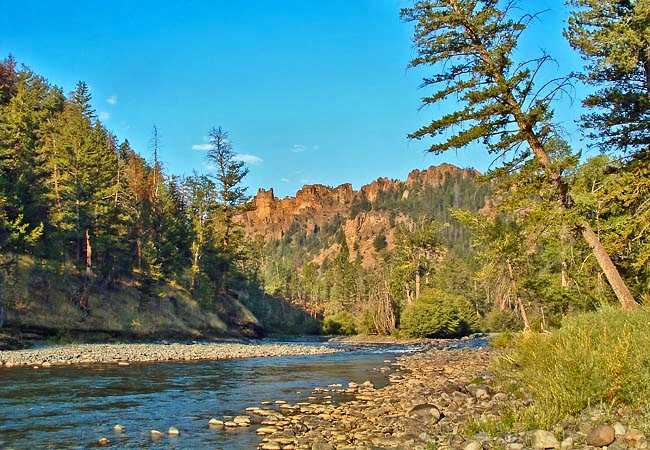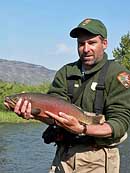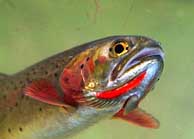|
Scenic USA - Wyoming Shoshone River |

| Photo by Ben Prepelka Ben Prepelka Photography Inset images courtesy the NPS |
The Shoshone River is formed in the Absaroka Mountain Range of Yellowstone National Park in northwestern Wyoming.  The river is surrounded by the Shoshone National Forest, America's first national forest created as part of the Yellowstone Timberland Reserve in 1891. As the river flows in a northeast direction, it passes Cody, Wyoming and joins the Bighorn River near the Montana border.
The river is surrounded by the Shoshone National Forest, America's first national forest created as part of the Yellowstone Timberland Reserve in 1891. As the river flows in a northeast direction, it passes Cody, Wyoming and joins the Bighorn River near the Montana border.
John Colter, famous explorer and trapper of the early 1800s, originally named the river Stinking Water when he encountered the strong sulfur odor at a geo-thermal spring on the river. It's easy to guess why the Wyoming legislature later changed the name to Shoshone River. Named after a western band of Shoshones, the meaning of the name, abundance of grass, is a reference to the tribe's grass lodges.
Meriwether Lewis and his men, of Lewis and Clark Corps of Discovery Expedition, were the first white people to visit the Shoshone Indians in modern day Montana and Idaho. Unable to proceed up the Missouri River by boat, the expedition realized their trip over the Rockies and Bitterroot mountains required a different plan. Lewis hoped to acquire horses and a guide from the Shoshones. Before Lewis had met the Indians, he had written, "If we do not find [the Shoshones], I fear the successful issue of our voyage will be very doubtful.” Help from area natives can never be overstated in the journals of Lewis and Clark. Many times during the two and a half year journey, friendly Indians interceded on their behalf.
Following U.S. Route 20 westward from Cody to the east entrance to Yellowstone National Park, the North Fork of the Shoshone  River is often overlooked as a fishing opportunity. Rated one of the top 10 freestone rivers in the Rocky Mountains, the North Shoshone offers 50 miles of prime fishing adventure. Aside from aquatic wildlife, the forest is also a haven for elk, moose, mule deer, bighorn sheep, black bear and grizzlies. A mix of private and public land surrounds the river, offering many access points for wade fishing and float trips. Native cutthroats, rainbows, and brown trout are the dominant species here, with occasional catches of brook trout and Rocky Mountain whitefish. While the majority of travelers are bound for Yellowstone, a few avid anglers will stop and take advantage of this pristine mountain stream.
River is often overlooked as a fishing opportunity. Rated one of the top 10 freestone rivers in the Rocky Mountains, the North Shoshone offers 50 miles of prime fishing adventure. Aside from aquatic wildlife, the forest is also a haven for elk, moose, mule deer, bighorn sheep, black bear and grizzlies. A mix of private and public land surrounds the river, offering many access points for wade fishing and float trips. Native cutthroats, rainbows, and brown trout are the dominant species here, with occasional catches of brook trout and Rocky Mountain whitefish. While the majority of travelers are bound for Yellowstone, a few avid anglers will stop and take advantage of this pristine mountain stream.
Area Map

|
Additional Points of Interest |
Scenic USA Prints from
|
Copyright © 2023 Benjamin Prepelka
All Rights Reserved

